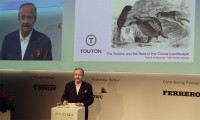“Sustainability” – particularly the sustainable production of cocoa and chocolate – was the core theme of the international Chocovision conference recently held in Davos/Switzerland. Hosted by leading cocoa and chocolate producer Barry Callebaut, the conference illumi- nated the serious problems of the cocoa sector in the countries where cocoa is cultivated, such as poverty and the destruction of the environment, and highlighted solutions.
By Dr. Bernhard Reichenbach
The facts: there are some 5.5 million cocoa farmers around the world. Cultivating the plant is a work-intensive process ensuring the livelihood of around 15 million people, primarily in West Africa. This region accounts for approximately 70 % of the world’s raw cocoa production, which totalled around 4.7 m t during the harvest year of 2016/17 (2015/16 around 4 m t). Meanwhile, almost half of the production is processed into semi-finished products in their countries of origin.
Yet, the cocoa sector is struggling with significant problems. 90 % of the world’s cocoa cultivation, especially in West Africa, is carried out on relatively small lots of land, some not even occupying 1 ha. This small farm structure is often economically inefficient. Things are different in Latin America, where cocoa is frequently farmed on large plantations. While this approach is generally more profitable, it also leads to the formation of monocultures and the loss of natural surroundings.
In Africa, the problems are nevertheless notably more severe. The small, family-run operations there hardly earn enough to subsist. Significant fluctuations in production and prices, combined with speculation and corruption, dominate at the expense of the cocoa farmers. The consequences include exploitation, poverty, rural depopulation and migration abroad. Unrestrained population growth results in the constant clearing and planting of new farmland to the detriment of the rainforest, which is shrinking drastically. The deforestation feeds climate change and the formation of desert land as a result of less rainfall.
The three-day Chocovision conference recently held in Davos/Switzerland examined all these problems and their potential solution. Since 2012, the conference has been held every two years, gathering together the movers and shakers of the cocoa, chocolate and confectionery industries to discuss strategic issues of mutual interest.
This year’s Chocovision assembled over 200 figures from the fields of business, politics and civil society. Guests included the former Norwegian Prime Minister and “sustainability prophet” Dr Gro Harlem Brundtland, and climate change expert Christiana Figueres. The attendees discussed how they can cooperate to ensure a sustainable future along a transparent cocoa/chocolate value chain for all of the interested parties, from farmers to producers, traders and consumers; a future without poverty and destruction of the environment, child labour and gender inequality.
Representatives from all of these interest groups spoke against the backdrop of the fact that the farmers themselves ultimately receive only around 3 % of the revenues generated with chocolate – an amount in many cases hardly capable of securing their subsistence. As the leaders of tomorrow, younger conference attendees were also included in opinion-making panel discussions. Three rounds of discussions examined how modern technologies such as genetics, artificial intelligence or E-commerce can help drive and promote innovation in the chocolate sector, how a materially secure and sustainable “chocolate future” specifically for the farming sector can be ensured, and what role business and the economy play in all this.
The development of the cocoa sector in Ecuador was presented as a positive example. Between 2012/13 and 2016/17, Ecuador increased its production by 40 %, elevating the nation to the status of the world’s fourth-largest cocoa producer. The country aims to rise even further over the next ten years to the No. 2 position. The average yield per hectare rose during the four-year period from less than 500 kg to more than 2,000 kg. In contrast, in Africa the current average yield is barely above 500 kg. The driving forces behind this “revolution” are the introduction of the dollar as the accounting unit, larger farming plots of around 5 ha in size, and improved technology and mechanisation. As a result, the daily income of well-trained farmers and farm workers there has risen from a previous level of USD 6 to a rate of USD 27 today.
The production of cocoa and chocolate needs to ensure a sustainable, environmentally-friendly value chain that reduces waste and energy consumption, and that also offers prosperity to all of the parties involved. To achieve this, Ian Roberts, Chief Technology Officer at the Bühler Group, emphasised the special importance of transparency “from bean to bar” in order to guarantee food product safety and integrity. In his presentation he underscored how “Comprehensive transparency requires a heretofore unknown level of cooperation between all of the stakeholders, new business practices and the appropriate new technology”. Examples of such new technologies include the genetic traceability of the products to their origins and the secure transmission of data, for example by means such as block chain.
Aldo Uva, the COO of Ferrero, sees an absolute necessity in placing the “cocoa farmers at the centre of activities” in order to break the vicious cycle of poverty in the countries where the plant is cultivated. A good living income should ensure that young people become cocoa farmers by choice, and not by chance like in the past. The farmers should receive the aide of advisors and trainers to support them in giving up outdated agricultural practices in favour of new methods of working. For example, by adopting professional management and mechanisation, hazelnut produ-cers in Turkey have been able to increase their per-hectare harvest yields from 650 kg to 1100 kg in only two years. Mr Uva emphasised: “This experience can be seamlessly applied directly to the cocoa sector”.
Investments in improving the situation in the countries of production represent longer-term measures that are not aimed at achieving short-term effects. This was illustrated by Patrick de Boussac, CEO of the French ingredient supplier Touton, who used the example of the slow-moving turtle that ultimately succeeded competing with the quick but careless hare. Investment must, for instance, be made in diversified farming in order to break the dependence on a single product such as cocoa and the development of its pricing. But first, this requires acquiring detailed knowledge of the presiding local circumstances so as to avoid missteps.







